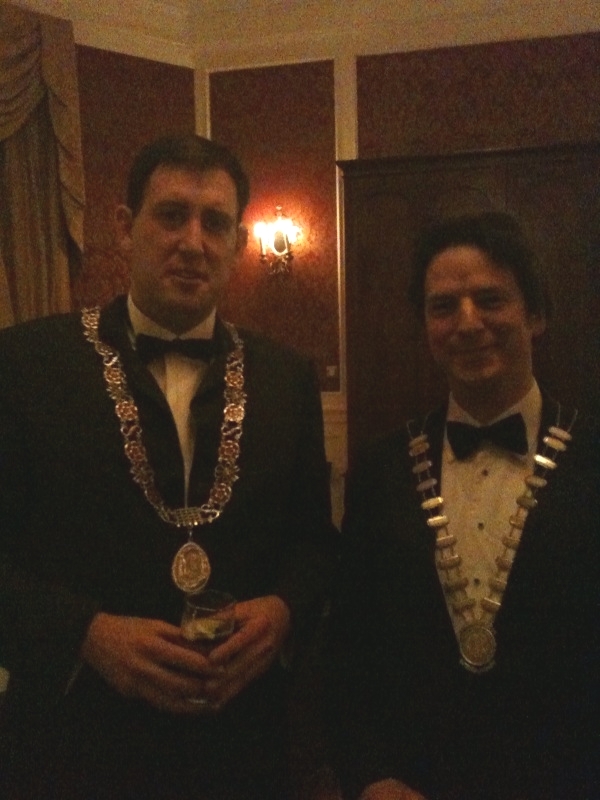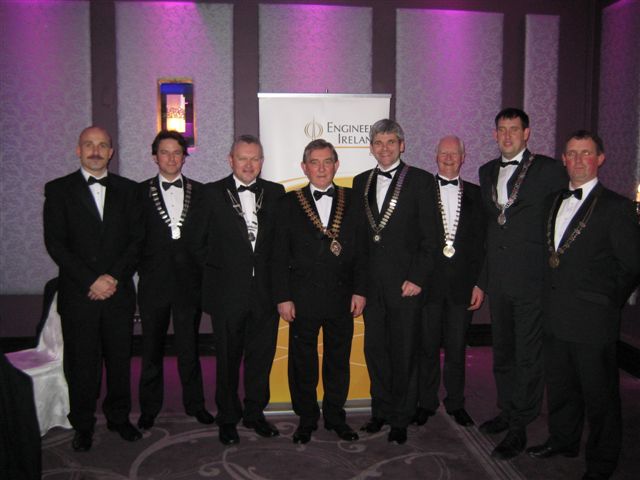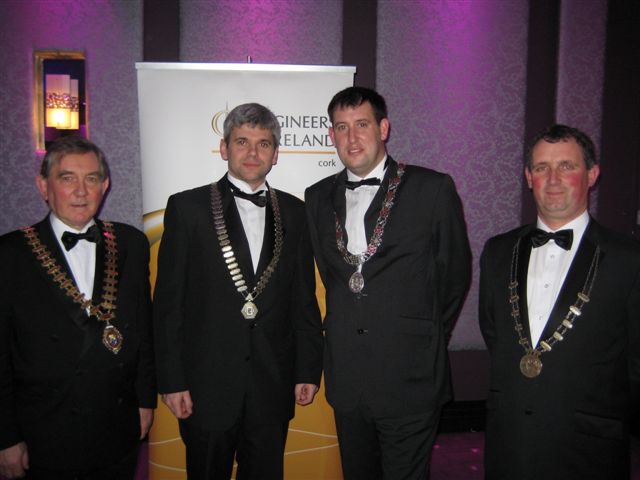Last night I had the pleasure and honour of deputising for the Lord Mayor attending at the Engineer’s Ireland, Cork Region annual dinner at the Maryborough Hotel, Cork (11 February 2011)
http://www.engineersirelandcork.ie/
Kieran’s Speech:
Engineering a New Ireland
 Deputy County Mayor, President of Engineers Ireland, Director General of Engineers Ireland, chairmen, ladies and gentlemen,
Deputy County Mayor, President of Engineers Ireland, Director General of Engineers Ireland, chairmen, ladies and gentlemen,
On behalf of the Lord Mayor, thanks very much for the invitation to speak here this evening. This is my second time in a short space of time being in a position to address you.
The last time I had my historian and geographers hat on in congratulating you on your milestone, 175 years a growing and giving the group an insight into Cork in 1835 (last April at the top of County Hall).
With my councillor’s hat on this evening, I can’t speak with confidence about my grasp about the discipline and practice of engineering but would like to share some thoughts from a geographer’s perspective on it.
As a child, certainly the Irish education system gave me a great grounding in maths and learning my sums. But I was never any good at solving problem maths especially the complex algebra sums of this world- my young mind was not conditioned to see the steps required to resolve such sums.
However, because of an enthusiastic teacher, I pursued physics and applied maths at leaving cert level. He showed us that to resolve algebraic equations, you need not only have to have a grasp of formulae but also ability to see the answer as a series of steps to come up with it. I developed huge interests in energy and inertia – grasped the knock on affects on objects – positive and negative – how new forces of energy could be made. I learned to approach mathematical problems step by step.
However, the courses like many school subjects did not show me the practical uses of physics, applies maths – the role of science in conceiving, developing and implementing new technologies in engineering and design. I see in today’s world, there is a more active approach to understanding the impacts through ventures such as the annual Engineering Week coming up this week.
Thesis imaginations:
Recently, with my perusal of a thesis in geography and exploring ideas of landscape and memory and how people remember on the landscape through features such as ruins, memorials, pilgrimage-and whilst compiling my literature review once more my gaze on applied maths came into being as a I drew a memory system and its dynamics. It was aimed to capture and unravel or unpack the quite complex processes – inputs, interactions and outcomes involved in the production of memory.
My ongoing work involves excavating concepts of collective memory and how collective memory is created on the landscape and how this legacy and heritage affects the quality of the natural and built environment.
Cork City Imaginations:
With that in mind, I have often marvelled in my research on how our city is built on a swamp – a fantastic piece of engineering in itself. I marvel at the city’s human built fabric – its higgely piggely architecture – how it sits in a basin crawling out as to grab its hilly suburbs as if to make sure it doesn’t completely sink. The concept of place-making in Cork also interests me and the multi dimensional perspectives that go with that and the effect on values, perceptions and beliefs on its people.
Cork City’s evolution can be narrated and conceived as an unfolding succession of stories; various people coming and going through the ages, leaving their own mark on the city and region. Cork’s urban landscape or textbook is throbbing with messages about the past, present and future. This throbbing or energy- with all its tensions, flows, complexities, even down to the look of the city’s architecture, cogwheels of traffic and people flows- all create the momentum to drive the city on –
The city’s poetic landscape of architectural monuments link to some form of celebration of the living past and present. Those links in turn combine to create a strong sense of place, emotional attachment and identity. That place-making can be sometimes located in space, and at other times in the mind.
A Number of Views:
Walking around the city, researching and photographing I’m often taken by a number of things:
-the curvature in the cityscape, its colours and shapes that constantly seems to frustrate the eye anxious for symmetry or linear simplicity…every few metres Cork’s landscape changes; it always surprises, offering ever new vistas.
–I’m a big fan of the city’s 30 or so bridges…from the elegant Georgian stonework of bridges such as Parliament Bridge to the Victorian ironwork on bridges such as St. Vincent’s Bridge to Daly’s bridge –our Shaky bridge – all evoke a sense of time and are illustrated histories of a moment in history – many of which we know the basic history about but that’s it. Every time I stand on the Shaky Bridge, I always think about the firm who designed the bridge and ask, would they be proud that their suspension bridge became a structure that Cork people wanted to shake.
-I also like to stop on St. Patrick’s bridge to admire how the houses in Gurranabraher are set into the steep hillside of Cork’s northside- but this urban landscapes, since the first social housing unit opened in 1934, are re-interpreted by each generation of viewers –from a space of habitation to a space of sociability, performance and play.
-I’m also a fan when a view is given of the brick work when an old building has to be taken down. The multiple bricks and limestone and sandstone used, laying neatly but almost randomly on top of each other give one access to the imagination and efforts of the people who drew up their design, the people who had sleepless nights thinking about their work and the people, the actual engineers and workers who strived hard and long to bring and weave the jigsaw pieces of an architect’s imagination together. These places present dense and disorganised `collages’ of memory and past human energies of the city.
-I’m also a fan of the City’s archaeology. The old maps of the city – showing how the city came into being – casting an eye on the maps, one can’t help but think about past cultures, creativity, emotion, conflict, belief systems and community ideologies
Cork Shows Us:
Cork’s landscape is indeed something ancient, soulful and purposeful – something motivating and ambitious. It’s as if the human built world does provide the landscape with a voice. For the walker, explorer, geographer like me, the human built fabric creates a landscape of living encounters, experiences, connections, journeys, ideas and re-interpretations.
So there is a huge importance in acknowledging the processes of engineering – from the moments of revelation, to the sets of knowledge creation to the created energies and forms.
Perhaps what is also important and that really shines across in the engineering field is yes the need for a vision but also a real step by step plan.
But Cork’s architecture shows us much – talent, confidence, self pride, self belief and innovation. And ladies and gentlemen, in the Ireland of today, we need more of such confidence, pride and belief and innovation– we need to mass produce these qualities and step by step approaches to pursue them.
Ladies and gentlemen, now is our time to build our legacy and we must pursue this with energy and force in these uncertain economic times. The economic recovery road ahead is going to be long. We know that but perhaps what is not as apparent is that we need not only a vision but real, tangible, positive ideas and a step by step approach to make ideas a reality.
Now is our time to make a difference and not to shy away from it.
As I see is customary, The lord mayor is to propose a toast to engineer’s Ireland.
So I will call you wish to stand… and perhaps tonight as we propose engineers Ireland, we should all take away one thing that you will pursue to make Ireland a better place.
To Engineer’s Ireland.
Go raibh maith agaibh

